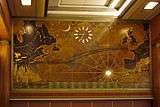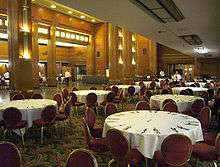RMS Queen Mary
 RMS Queen Mary in Long Beach, California | |
| History | |
|---|---|
| Name: | Queen Mary |
| Namesake: | Queen Mary, consort of King George V |
| Owner: |
|
| Port of registry: | Liverpool |
| Route: | Southampton, New York, via Cherbourg (normal transatlantic voyage East and West bound) |
| Ordered: | 3 April 1929 |
| Builder: |
|
| Yard number: | 534 |
| Laid down: | 1 December 1930 |
| Launched: | 26 September 1934 |
| Sponsored by: | Queen Mary |
| Christened: | 26 September 1934 |
| Maiden voyage: | 27 May 1936 |
| Out of service: | 9 December 1967 (retired) |
| Identification: | Radio Callsign GBTT |
| Status: | museum ship |
| General characteristics | |
| Type: | Ocean liner |
| Tonnage: | 81,237 GRT |
| Displacement: | 81,961 tons |
| Length: | |
| Beam: | 118 ft (36.0 m) |
| Height: | 181 ft (55.2 m) |
| Draught: | 39 ft (11.9 m) |
| Decks: | 12 |
| Installed power: | 24 × Yarrow boilers |
| Propulsion: | |
| Speed: |
|
| Capacity: | 2,139 passengers: 776 first (cabin) class, 784 cabin class, 579 tourist class |
| Crew: | 1101 |
|
RMS Queen Mary | |
 | |
| Coordinates | 33°45′11″N 118°11′23″W / 33.75306°N 118.18972°WCoordinates: 33°45′11″N 118°11′23″W / 33.75306°N 118.18972°W |
| NRHP Reference # | 92001714[2] |
| Added to NRHP | 15 April 1993 |
RMS Queen Mary is a retired ocean liner that sailed primarily on the North Atlantic Ocean from 1936 to 1967 for the Cunard Line (known as Cunard-White Star Line when the vessel entered service). Built by John Brown & Company in Clydebank, Scotland, Queen Mary, along with RMS Queen Elizabeth,[3] were built as part of Cunard's planned two-ship weekly express service between Southampton, Cherbourg and New York. The two ships were a British response to the express superliners built by German, Italian and French companies in the late 1920s and early 1930s. Queen Mary was the flagship of the Cunard Line from May 1936 until October 1946 when she was replaced in that role by Queen Elizabeth.
Queen Mary sailed on her maiden voyage on 27 May 1936 and captured the Blue Riband in August of that year; she lost the title to SS Normandie in 1937 and recaptured it in 1938, holding it until 1952 when she was beaten by the new SS United States. With the outbreak of the Second World War, she was converted into a troopship and ferried Allied soldiers for the duration of the war.
Following the war, Queen Mary was refitted for passenger service and along with Queen Elizabeth commenced the two-ship transatlantic passenger service for which the two ships were initially built. The two ships dominated the transatlantic passenger transportation market until the dawn of the jet age in the late 1950s. By the mid-1960s, Queen Mary was ageing and, though still among the most popular transatlantic liners, was operating at a loss.
After several years of decreased profits for Cunard Line, Queen Mary was officially retired from service in 1967. She left Southampton for the last time on 31 October 1967 and sailed to the port of Long Beach, California, United States, where she remains permanently moored. Much of the machinery, including one of the two engine rooms, three of the four propellers, and all of the boilers, were removed. The ship serves as a tourist attraction featuring restaurants, a museum and a hotel. The ship is listed on the National Register of Historic Places. The National Trust for Historic Preservation has accepted the Queen Mary as part of the Historic Hotels of America.[4]
Construction and naming
With Germany launching Bremen and Europa into service, Britain did not want to be left behind in the shipbuilding race. White Star Line began construction on their 80,000-ton Oceanic in 1928, while Cunard planned a 75,000-ton unnamed ship of their own.
.jpg)
Construction on the ship, then known only as "Hull Number 534",[5] began in December 1930 on the River Clyde by the John Brown & Company shipyard at Clydebank in Scotland. Work was halted in December 1931 due to the Great Depression and Cunard applied to the British Government for a loan to complete 534. The loan was granted, with enough money to complete the unfinished ship, and also to build a running mate, with the intention to provide the weekly service to New York with just two ships.[6]
One condition of the loan was that Cunard would merge with the White Star Line, which was Cunard's chief British rival at the time and which had already been forced by the depression to cancel construction of its Oceanic. Both lines agreed and the merger was completed on 10 May 1934. Work on Queen Mary resumed immediately and she was launched on 26 September 1934. Completion ultimately took 3 1⁄2 years and cost 3.5 million pounds sterling.[6] Much of the ship's interior was designed and constructed by the Bromsgrove Guild.[7]
The ship was named after Queen Mary, consort of King George V. Until her launch, the name she was to be given was kept a closely guarded secret. Legend has it that Cunard intended to name the ship Victoria, in keeping with company tradition of giving its ships names ending in "ia", but when company representatives asked the king's permission to name the ocean liner after Britain's "greatest queen", he said his wife, Queen Mary, would be delighted.[8] And so, the legend goes, the delegation had of course no other choice but to report that No. 534 would be called Queen Mary.[8]
This story was denied by company officials, and traditionally the names of sovereigns have only been used for capital ships of the Royal Navy. Some support for the story was provided by Washington Post editor Felix Morley, who sailed as a guest of the Cunard Line on Queen Mary's 1936 maiden voyage. In his 1979 autobiography, For the Record, Morley wrote that he was placed at table with Sir Percy Bates, chairman of the Cunard Line. Bates told him the story of the naming of the ship "on condition you won't print it during my lifetime." The name Queen Mary could also have been decided upon as a compromise between Cunard and the White Star Line, as both lines had traditions of using names either ending in "ic" with White Star and "ia" with Cunard.[8]
The name had already been given to the Clyde turbine steamer TS Queen Mary, so Cunard made an arrangement with its owners and this older ship was renamed Queen Mary II.[9]
Queen Mary was fitted with 24 Yarrow boilers in four boiler rooms and four Parsons turbines in two engine rooms. The boilers delivered 400 pounds per square inch (28 bar) steam at 700 °F (371 °C) which provided a maximum of 212,000 shp (158,000 kW) to four propellers, each turning at 200 RPM.[10] Queen Mary achieved 32.84 knots on her acceptance trials in early 1936.[11]
History (1934–1939)
In 1934 the new liner was launched by Queen Mary as RMS Queen Mary. On her way down the slipway, Queen Mary was slowed by eighteen drag chains, which checked the liner's progress into the Clyde, a portion of which had been widened to accommodate the launch.[12]
When she sailed on her maiden voyage from Southampton on 27 May 1936, she was commanded by Sir Edgar T. Britten, who had been the master designate for Cunard White Star whilst the ship was under construction at the John Brown shipyard. Queen Mary measured 80,774 gross register tons (GRT).[13] Her rival Normandie, which originally grossed 79,280 tonnes, had been modified the preceding winter to increase her size to 83,243 GRT (an enclosed tourist lounge was built on the aft boat deck on the area where the game court was), and therefore kept the title of the world's largest ocean liner.[14] Queen Mary sailed at high speeds for most of her maiden voyage to New York, until heavy fog forced a reduction of speed on the final day of the crossing, arriving in New York Harbor on 1 June.

Queen Mary's design was criticised for being too traditional, especially when Normandie's hull was revolutionary with a clipper-shaped, streamlined bow. Except for her cruiser stern, she seemed to be an enlarged version of her Cunard predecessors from the pre–First World War era. Her interior design, while mostly Art Deco, seemed restrained and conservative when compared to the ultramodern French liner. Queen Mary proved to be the more popular vessel than her larger rival, in terms of passengers carried.[8][15]
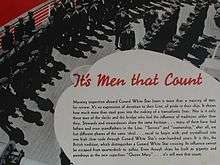
In August 1936, Queen Mary captured the Blue Riband from Normandie, with average speeds of 30.14 knots (55.82 km/h; 34.68 mph) westbound and 30.63 knots (56.73 km/h; 35.25 mph) eastbound. Normandie was refitted with a new set of propellers in 1937 and reclaimed the honour, but in 1938 Queen Mary took back the Blue Riband in both directions with average speeds of 30.99 knots (57.39 km/h; 35.66 mph) westbound and 31.69 knots (58.69 km/h; 36.47 mph) eastbound, records which stood until lost to United States in 1952.
Interior
Among facilities available on board Queen Mary, the liner featured two indoor swimming pools, beauty salons, libraries and children's nurseries for all three classes, a music studio and lecture hall, telephone connectivity to anywhere in the world, outdoor paddle tennis courts and dog kennels. The largest room onboard was the cabin class (first class) main dining room (grand salon), spanning three stories in height and anchored by wide columns. The cabin-class swimming pool facility spanned over two decks in height. This was the first ocean liner to be equipped with her own Jewish prayer room – part of a policy to show that British shipping lines avoided the racism evident at that time in Nazi Germany.[16]
The cabin-class main dining room featured a large map of the transatlantic crossing, with twin tracks symbolising the winter/spring route (further south to avoid icebergs) and the summer/autumn route. During each crossing, a motorised model of Queen Mary would indicate the vessel's progress en route.
As an alternative to the main dining room, Queen Mary featured a separate cabin-class Verandah Grill on the Sun Deck at the upper aft of the ship. The Verandah Grill was an exclusive à la carte restaurant with a capacity of approximately eighty passengers, and was converted to the Starlight Club at night. Also on board was the Observation Bar, an Art Deco-styled lounge with wide ocean views.
Woods from different regions of the British Empire were used in her public rooms and staterooms. Accommodation ranged from fully equipped, luxurious cabin (first) class staterooms to modest and cramped third-class cabins. Artists commissioned by Cunard in 1933 for works of art in the interior include Edward Wadsworth and A. Duncan Carse.[17]
| Queen Mary Art Deco Interiors | ||||||
|---|---|---|---|---|---|---|
|
Second World War

In late August 1939, Queen Mary was on a return run from New York to Southampton. The international situation led to her being escorted by the battlecruiser HMS Hood. She arrived safely, and set out again for New York on 1 September. By the time she arrived, the Second World War had started and she was ordered to remain in port alongside Normandie until further notice.
In March 1940 Queen Mary and Normandie were joined in New York by Queen Mary's new sister ship Queen Elizabeth, fresh from her secret dash from Clydebank. The three largest liners in the world sat idle for some time until the Allied commanders decided that all three ships could be used as troopships. Normandie was destroyed by fire during her troopship conversion. Queen Mary left New York for Sydney, Australia, where she, along with several other liners, was converted into a troopship to carry Australian and New Zealand soldiers to the United Kingdom.
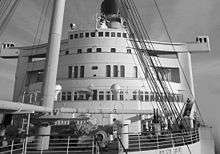
In the Second World War conversion, the ship's hull, superstructure and funnels were painted navy grey. As a result of her new colour, and in combination with her great speed, she became known as the "Grey Ghost." To protect against magnetic mines, a degaussing coil was fitted around the outside of the hull. Inside, stateroom furniture and decoration were removed and replaced with triple-tiered wooden bunks, which were later replaced by standee bunks.
Six miles of carpet, 220 cases of china, crystal and silver service, tapestries and paintings were removed and stored in warehouses for the duration of the war. The woodwork in the staterooms, the cabin-class dining room and other public areas was covered with leather. Queen Mary and Queen Elizabeth were the largest and fastest troopships involved in the war, often carrying as many as 15,000 men in a single voyage, and often travelling out of convoy and without escort. Their high speed made it difficult for U boats to catch them.
On 2 October 1942, Queen Mary accidentally sank one of her escort ships, slicing through the light cruiser HMS Curacoa off the Irish coast with a loss of 239 lives. Queen Mary was carrying thousands of Americans of the 29th Infantry Division[18] to join the Allied forces in Europe.[19] Due to the risk of U-boat attacks, Queen Mary was under orders not to stop under any circumstances and steamed onward with a fractured stem. Some sources claim that hours later, the convoy's lead escort returned to rescue 99 survivors of Curacoa's crew of 338, including her captain John W. Boutwood.[20][21][22] This claim is contradicted by the liner's then Staff Captain (and later Cunard Commodore) Harry Grattidge, who records that Queen Mary's Captain immediately ordered the accompanying destroyers to look for survivors within moments of the Curacoa's sinking.[23]
In December 1942, Queen Mary carried 16,082 American soldiers from New York to Great Britain,[24] a standing record for the most passengers ever transported on one vessel.[25] During this trip, while 700 miles (1,100 km) from Scotland during a gale, she was suddenly hit broadside by a rogue wave that may have reached a height of 28 metres (92 ft). An account of this crossing can be found in Carter's book.[24][26] As quoted in the book, Carter's father, Dr. Norval Carter, part of the 110th Station Hospital on board at the time, wrote in a letter that at one point Queen Mary "damned near capsized... One moment the top deck was at its usual height and then, swoom! Down, over, and forward she would pitch." It was calculated later that the ship rolled 52 degrees, and would have capsized had she rolled another 3 degrees.[24] The incident inspired Paul Gallico to write his novel, The Poseidon Adventure (1969) and carry the incident to a fictional extreme. This was adapted as a 1972 film by the same name, in which the SS Poseidon is turned upside-down, and the trapped passengers try to escape. Naturally parts of the film were shot in the actual Queen Mary, conveniently docked in Long Beach.
During the war Queen Mary carried British Prime Minister Winston Churchill across the Atlantic for meetings with fellow Allied forces officials on several occasions. He was listed on the passenger manifest as "Colonel Warden".[27] The ship was also used to return American troops from Europe after the war.
Post Second World War

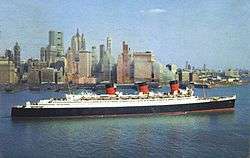
After delivering a load of war brides to Canada, Queen Mary made her fastest ever crossing, returning to Southampton in only three days, 22 hours and 42 minutes at an average speed of just under 32 knots (59 km/h).[28] From September 1946 to July 1947, Queen Mary was refitted for passenger service, adding air conditioning and upgrading her berth configuration to 711 first class (formerly called cabin class), 707 cabin class (formerly tourist class) and 577 tourist class (formerly third class) passengers.[29] Following refit, Queen Mary and Queen Elizabeth dominated the transatlantic passenger trade as Cunard White Star's two-ship weekly express service through the latter half of the 1940s and well into the 1950s. They proved highly profitable for Cunard (as the company was renamed in 1947).
On 1 January 1949, Queen Mary ran aground off Cherbourg, France. She was refloated the next day[30] and returned to service.
In 1958 the first transatlantic flight by a jet began a completely new era of competition for the Cunard Queens. On some voyages, winters especially, Queen Mary sailed into harbour with more crew than passengers, though both she and Queen Elizabeth still averaged over 1,000 passengers per crossing into the middle 1960s.[31] By 1965, the entire Cunard fleet was operating at a loss.
Hoping to continue financing the Queen Elizabeth 2 which was under construction at Brown's shipyard - Cunard mortgaged the majority of the fleet. Due to a combination of age, lack of public interest, inefficiency in a new market and the damaging after effects of the national seamen's strike, Cunard announced that both Queen Mary and Queen Elizabeth would be retired from service and sold off. Many offers were submitted, and the bid of $3.45m/£1.2m from Long Beach, California beat the Japanese scrap merchants.[32] Queen Mary was featured in the 1966 action-adventure film Assault on a Queen starring Frank Sinatra.
Queen Mary was retired from service in 1967.[33] On 27 September she completed her 1,000th and last crossing of the North Atlantic, having carried 2,112,000 passengers over 3,792,227 miles (6,102,998 km). Under the command of Captain John Treasure Jones, who had been her captain since 1965, she sailed from Southampton for the last time on 31 October with 1,093 passengers and 806 crew. After an epic voyage around Cape Horn, she arrived in Long Beach on 9 December.[32] Queen Elizabeth was withdrawn in 1968 and Queen Elizabeth 2 took over the transatlantic route in 1969.
Long Beach
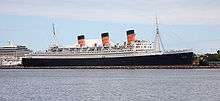
Queen Mary is permanently moored as a tourist attraction, hotel, museum and event facility in Long Beach. From 1983 to 1993, Howard Hughes' plane Spruce Goose, was located in a large dome nearby. The dome was later repurposed as a soundstage for film and television.[34] The structure is now used by Carnival Cruise Lines as a ship terminal, as a venue for the Long Beach Derby Gals roller derby team[35] and as an event venue.[36]
Since drilling had started for oil in Long Beach Harbor, some of the revenue had been set aside in the "Tidelands Oil Fund." Some of this money was allocated in 1958 for the future purchase of a maritime museum for Long Beach.[37]
Conversion
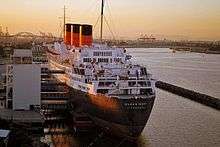
When Queen Mary was bought by Long Beach, the new owners decided not to preserve her as an ocean liner. It had been decided to clear almost every area of the ship below "C" deck (called "R" deck after 1950, to lessen passenger confusion, as the restaurants were located on "R" deck) to make way for Jacques Cousteau's new Living Sea Museum. This increased museum space to 400,000 square feet (37,000 m2).
It required removal of all the boiler rooms, the forward engine room, both turbo generator rooms, the ship stabilisers and the water softening plant. The ship's empty fuel tanks were filled with local mud to keep the ship's centre of gravity and draft at the correct levels, as these critical factors had been affected by the removal of the various components and structure. Only the aft engine room and "shaft alley", at the stern of the ship, would be spared. Remaining space would be used for storage or office space.
One problem that arose during the conversion was a dispute between land-based and maritime unions over conversion jobs. The United States Coast Guard had final say. Queen Mary was deemed a building, since most of her propellers had been removed and her machinery gutted. The ship was also repainted with its red water level paint at a slightly higher level than previously. During the conversion the funnels were removed, as this area was needed to lift out the scrap materials from the engine and boiler rooms. Workers found that the funnels were significantly degraded and they were replaced with replicas.

With all of the lower decks nearly gutted from R deck and down, Diners Club, the initial lessee of the ship, converted the remainder of the vessel into a hotel. Diners Club Queen Mary dissolved and vacated the ship in 1970 after their parent company, Diners Club International, was sold, and a change in corporate direction was mandated during the conversion process. Specialty Restaurants, a Los Angeles-based company that focused on theme-based restaurants, took over as master lessee the following year.
This second plan was based on converting most of her first- and second-class cabins on A and B decks into hotel rooms, and converting the main lounges and dining rooms into banquet spaces. On Promenade Deck, the starboard promenade was enclosed to feature an upscale restaurant and café named Lord Nelson's and Lady Hamilton's; it was themed in the fashion of early-19th century sailing ships. The famed and elegant Observation Bar was redecorated as a western-themed bar.
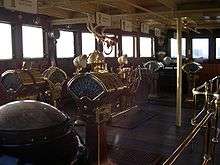
The smaller first-class public rooms, such as the Drawing Room, Library, Lecture Room and the Music Studio, would be stripped of most of their fittings and converted to commercial use. This markedly expanded retail space on the ship. Two more shopping malls were built on the Sun Deck in separate spaces previously used for first-class cabins and engineers' quarters.
A post-war feature of the ship, the first-class cinema, was removed for kitchen space for the new Promenade Deck dining venues. The first-class lounge and smoking room were reconfigured and converted into banquet space. The second-class smoking room was subdivided into a wedding chapel and office space. On the Sun Deck, the elegant Verandah Grill would be gutted and converted into a fast-food eatery, while a new upscale dining venue was created directly above it on Sports Deck, in space once used for crew quarters.
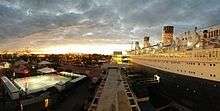
The second-class lounges were expanded to the sides of the ship and used for banqueting. On R deck, the first-class dining room was reconfigured and subdivided into two banquet venues, the Royal Salon and the Windsor Room. The second-class dining room was subdivided into kitchen storage and a crew mess hall, while the third-class dining room was initially used as storage and crew space.
Also on R deck, the first-class Turkish bath complex, the 1930s equivalent to a spa, was removed. The second-class pool was removed and its space initially used for office space, while the first-class swimming pool was open for viewing by hotel guests and visitors. Because of modern safety codes and the compromised structural soundness of the area directly below, the swimming pool could not be used for swimming after the conversion, although it was filled with water until the late 1980s. Today the pool can only be seen on guided tours and is in a derelict condition, having never been maintained by the hotel operators. No second-class, third-class or crew cabins remain intact aboard the ship today.
As a tourist attraction
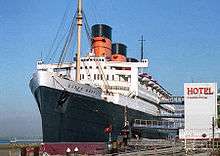
On 8 May 1971 Queen Mary opened her doors to tourists. Initially, only portions of the ship were open to the public as Specialty Restaurants had yet to open its dining venues and PSA had not completed work converting the ship's original First Class staterooms into the hotel. As a result, the ship was open only on weekends. On 11 December 1971 Jacques Cousteau's Museum of the Sea opened, with a quarter of the planned exhibits completed. Within the decade, Cousteau's museum closed due to low ticket sales and the deaths of many of the fish that were housed in the museum. On 2 November 1972 PSA's hotel opened its initial 150 guest rooms. Two years later, with all 400 rooms finished, PSA brought in Hyatt Hotels to manage the hotel. It operated the facility from 1974 to 1980 as the Queen Mary Hyatt Hotel.[38]
By 1980, it had become apparent that the existing system was not working.[39] The ship was losing millions each year for the city because the hotel, restaurants and museum were run by three separate concessionaires, while the city owned the vessel and operated guided tours. It was decided that a single operator with more experience in attractions was needed.[40]
Jack Wrather, a local millionaire, had fallen in love with the ship because he and his wife, Bonita Granville, had fond memories of sailing on it numerous times. Wrather signed a 66-year lease with the city of Long Beach to operate the entire property. He oversaw the display of the Spruce Goose, on long-term loan. The immense plane, which had been sitting in a hangar in Long Beach for decades unseen by the public, was installed in a huge geodesic dome adjacent to the liner in 1983, attracting increased attendance.[40]
His Wrather Port Properties operated the entire attraction after his death in 1984 until 1988, when his holdings were bought by the Walt Disney Company. Wrather had built the Disneyland Hotel in 1955, when Walt Disney had insufficient funds to construct the resort himself. Disney had been trying to buy the hotel for 30 years. When they finally succeeded, they also acquired the Queen Mary. This was never marketed as a Disney property.
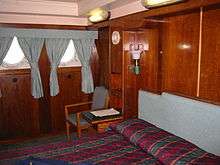
Through the late 1980s and early 1990s the Queen Mary struggled financially. Disney pinned their hopes for turning the attraction around on Port Disney,[41] a huge planned resort on the adjacent docks. It was to include a theme park known as DisneySea, themed around the world's oceans. The plans eventually fell through; in 1992 Disney gave up the lease on the ship to focus on building what would become Disney California Adventure Park. The DisneySea concept was recycled a decade later in Japan as Tokyo DisneySea, with a recreated ocean liner resembling Queen Mary named the SS Columbia as the centrepiece of the American Waterfront area.
With Disney gone, the Hotel Queen Mary closed on 30 September 1992. The owners of the Spruce Goose, the Aero Club of Southern California, sold the plane to the Evergreen Aviation & Space Museum in Oregon. The plane departed on barges on 2 October 1992, leaving the huge dome empty. The Queen Mary tourist attraction remained open for another two months, but on 31 December 1992, the Queen Mary completely closed her doors to tourists and visitors.
On 5 February 1993, RMS Foundation, Inc signed a five-year lease with the city of Long Beach to act as the operators of the property. The foundation was run by President and C.E.O. Joseph F. Prevratil, who had managed the attraction for Wrather. On 26 February 1993 the tourist attraction reopened completely, while the hotel reopened partially on 5 March with 125 rooms and the banquet facilities, with the remainder of the rooms coming on line on 30 April. In 1995, RMS Foundation's lease was extended to twenty years, while the scope of the lease was reduced to operation of the ship. A new company, Queen's Seaport Development, Inc. (QSDI), was established in 1995 to control the real estate adjacent to the vessel. In 1998, the city of Long Beach extended the QSDI lease to 66 years.

In 2005, QSDI sought Chapter 11 protection due to a rent credit dispute with the city. In 2006, the bankruptcy court requested bids from parties interested in taking over the lease from QSDI. The minimum required opening bid was $41M. The operation of the ship, by RMS Foundation, remained independent of the bankruptcy. In summer 2007, Queen Mary's lease was sold to a group named "Save the Queen," managed by Hostmark Hospitality Group.
They planned to develop the land adjacent to Queen Mary, and upgrade, renovate and restore the ship. During their management, staterooms were updated with iPod docking stations and flatscreen TVs and the ship's three funnels and waterline area were repainted their original Cunard Red color. The portside Promenade Deck's planking was restored and refinished. Many lifeboats were repaired and patched, and the ship's kitchens were renovated with new equipment.
In 2004, Queen Mary and Stargazer Productions added Tibbies Great American Cabaret to the space previously occupied by the ship's bank and wireless telegraph room. Stargazer Productions and Queen Mary transformed the space into a working dinner theatre complete with stage, lights, sound and scullery.[42]
In late September 2009, management of Queen Mary was taken over by Delaware North Companies, who plan to continue restoration and renovation of the ship and its property. They were determined to revitalise and enhance the ship as an attraction.[43] But in April 2011, The city of Long Beach was informed that Delaware North was no longer managing Queen Mary. Garrison Investment Group said this decision was purely business.[44] Delaware North still manages Scorpion, a Soviet submarine that has been a separate attraction next to Queen Mary since 1998.[45] Evolution Hospitality, LLC. assumed operational control of the Queen Mary on 23 September 2011, with Garrison Investments leasing Queen Mary.[46][47][48]
In 2016 Urban Commons, a real estate company, assumed the lease of the Queen Mary. They revealed plans to extensively renovate the liner over the next year, and to redevelop the adjacent 45 acres of parking with a boutique hotel, restaurants, a marina, an amphitheater, jogging trails, bike paths and possibly a huge Ferris wheel, all at a cost of up to $250 million.[49]
In 2017 a report on the ship's condition was issued. The report noted that not only the hull but also the supports for a raised exhibition area within the ship were corroding, and that the ship's deteriorating condition left areas such as the engine room vulnerable to flooding. Repairs were estimated at close to $300 million. In November 2016 the City of Long Beach had put $23 million toward addressing the Queen Mary's most vital repairs. John Keisler, economic and property development director for Long Beach, said, "We have a timeline in which the engineers believe they can complete those immediate projects. These are major challenges we can only address over time; it can't all be done at once." Political leaders in Scotland, birthplace of the Queen Mary, have called for UK Prime Minister Theresa May to pressure the American government to fund a full repair of the liner.[50]
Meeting of the Queens
On 23 February 2006, RMS Queen Mary 2 saluted her predecessor as she made a port of call in Los Angeles Harbor, while on a cruise to Mexico. On March 2011, Queen Mary was saluted by MS Queen Victoria while fireworks were going on, and on 12 March 2013, MS Queen Elizabeth made a salute while there were fireworks.[51]
The salute was carried out with Queen Mary replying with her one working air horn in response to Queen Mary 2 sounding her combination of two brand new horns and an original 1934 Queen Mary horn (on loan from the City of Long Beach).[52] Queen Mary originally had three whistles tuned to 55 Hz, a frequency chosen because it was low enough that the extremely loud sound of it would not be painful to human ears.[53]
Modern IMO regulations specify ships' horn frequencies to be in the range 70–200 Hz for vessels that are over 200 metres (660 ft) in length.[54] Traditionally, the lower the frequency, the larger the ship. Queen Mary 2, being 345 metres (1,132 ft) long, was given the lowest possible frequency (70 Hz) for her regulation whistles, in addition to the refurbished 55 Hz whistle on permanent loan. Fifty-five Hz is the "A" note an octave above the lowest note of a standard piano keyboard. The air-driven Tyfon whistle can be heard at least 10 miles (16 km) away.[55]
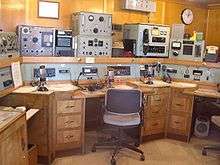
W6RO
Queen Mary's original, professionally manned wireless radio room was removed when the ship was moored in Long Beach. In its place, an amateur radio room was created one deck above the original radio reception room, with some of the discarded original radio equipment used for display purposes. The amateur radio station, with the call sign W6RO ("Whiskey Six Romeo Oscar"), relies on volunteers from a local amateur radio club. They staff the radio room during most public hours. The radios can also be used by other licensed amateur radio operators.[56][57][58]
In honour of his over forty years of dedication to W6RO and Queen Mary, in November 2007 the Queen Mary Wireless Room was renamed as the Nate Brightman Radio Room. This was announced on 28 October 2007, at Brightman's 90th birthday party by Joseph Prevratil, former President and CEO of the Queen Mary.
Claims of hauntings
Following Queen Mary's permanent docking in California, claims were made that the ship was haunted. [59] One of the staterooms is alleged be haunted by the spirit of a person who supposedly was murdered there.[60]
Paranormal researcher John Champion writes in Skeptical Inquirer Magazine that he understands why people persist in believing that the Queen Mary is haunted when the only evidence given is anecdotes, creepy feelings and shadows. Tourists who sign up for the haunted tour are given access to normally off-limit areas of the ship, while tours of the history of the ship are more limited. Champion believes that the owners are doing a disservice to the real history, the people who should be honoured "by remembering who they really were and what they actually did". He understands why people report strange occurrences, the ship still creaks and groans, and people's imaginations can get away from them such that they start seeing and hearing all kinds of things, attributing them to the paranormal which they have been primed for. "Ghost stories are fine", concludes Champion "when presented as such. The confusion of science and history with fiction ... gets us further away from the ability to relish in and truly explore our own recent history."[61]
See also
- RMS Mauretania (1938)
- MS Queen Elizabeth
- MS Queen Victoria
- RMS St Helena, one of the last Royal Mail Ships
References
- ↑ Watton, p.10.
- ↑ "NPS Focus". National Register of Historic Places. National Park Service. Retrieved 7 September 2011.
- ↑ "1938 newsreel of shipyard construction".
- ↑ "The Queen Mary". Historic Hotels of America. Retrieved 9 August 2013.
- ↑ "Four-Leaf Clover Propeller to Drive Giant Liner 534". Popular Mechanics. Hearst Magazines: 528. October 1934. ISSN 0032-4558. Retrieved 10 September 2012.
- 1 2 O'Connor, Sheila (2006). "Royal Lady – The Queen Mary Reigns in Long Beach". Go World Travel Magazine. Archived from the original on 7 September 2008. Retrieved 11 June 2013.
- ↑ "The Bromsgrove Guild – An Illustrated History". Bromsgrove Society. Archived from the original on 14 May 2008.
- 1 2 3 4 Maxtone-Graham, John (1972). The Only Way to Cross. New York: Collier Books. pp. 288–289.
- ↑ David Baldwin (2 February 2010). Royal Prayer: A Surprising History. A&C Black. p. 20. ISBN 978-0-8264-2303-0.
- ↑ Watton, pp.12-13.
- ↑ McCutcheon
- ↑ "Chains brake liner at launching". Popular Science. Bonnier Corporation: 20. December 1934. ISSN 0161-7370. Retrieved 2 November 2009.
- ↑ Layton, J. Kent. "R.M.S. Queen Mary". Atlantic Liners. Retrieved 10 September 2012.
- ↑ "SS Normandie". Ocean-liners.com. Retrieved 10 September 2012.
- ↑ Fritz Weaver, Fritz Weaver (narrator) (1996). Floating Palaces (TV Documentary). A&E.
- ↑ Evans, Nicholas J. (2010). "A Strike for Racial Justice? Transatlantic Shipping and the Jewish Diaspora, 1882–1939". In Jorden, James; Kushern, Tony; Pearce, Sarah. Jewish Journeys: From Philo to Hip Hop. London: Vallentine Mitchell. pp. 25–47. ISBN 978-0-85303-962-4.
- ↑ Sprague, Abbie N. (23 April 2008). "Modern art takes to the waves". Apollo: 8. Archived from the original on 6 January 2009. Retrieved 10 September 2012.
- ↑ Balkoski, Joseph. Beyond the Beachhead. Stackpole Books. pp. 37–38. ISBN 0-8117-0221-9.
- ↑ Brighton CSV Media Clubhouse (11 June 2004). "HMS Curaçao Tragedy". WW2 People's War. BBC. Retrieved 10 August 2009.
- ↑ Melomet, Andrew (July 2008). "Forever England". St. Mihiel Trip-Wire: July 2008. WorldWar1.com. Retrieved 10 August 2009.
- ↑ Queen Mary / Curacoa Crash. Disasters of the Century. History Television. 2009. Archived from the original on 10 May 2011.
- ↑ "Allied Warships – Light cruiser HMS Curacoa of the Ceres class". Uboat.net. Retrieved 10 September 2012.
- ↑ Grattidge and Collier, Captain of the Queens.
- 1 2 3 Levi, Ran. "The Wave That Changed Science". The Future of Things. Retrieved 11 June 2013.
- ↑ "The Queen Mary During WWII". QueenMary.com. Retrieved 11 June 2013.
- ↑ No Greater Sacrifice, No Greater Love, William Ford Carter, Smithsonian Books, Washington, 2004, page 55
- ↑ Lavery, Brian (2007). Churchill Goes to War: Winston's Wartime Journeys. Naval Institute Press. p. 213.
- ↑ Maddocks, p.155.
- ↑ "RMS Queen Mary". Ocean-liners.com. Retrieved 10 September 2012.
- ↑ "The Queen Mary Back In Port". The Times (51269). London. 3 January 1949. col E, p. 4.
- ↑ Harvey, Clive (2008). R.M.S. Queen Elizabeth – The Ultimate Ship. Carmania Press. ISBN 978-0-9543666-8-1.
- 1 2 Tramp to Queen: The Autobiography of Captain John Treasure Jones. The History Press. 2008. ISBN 0752446258.
- ↑ "Out to Sea and into History". Life. Vol. 63 no. 14. Time Inc. 6 October 1967. pp. 26–31. Retrieved 3 July 2017.
- ↑ Pinksy, Mark (10 March 1995). "Long Beach Dome Gets New Life in Film". Los Angeles Times. Retrieved 13 April 2015.
- ↑ "Long Beach Derby Gals". 2013. Retrieved 1 October 2013.
- ↑ "Queen Mary Dome". 2013. Retrieved 1 October 2013.
- ↑ "A Report on the Queensway Bay Development Plan and the Long Beach Tide and Submerged Lands" (PDF). State Lands Commission. April 2001.
- ↑ Malcolm, Andrew H (12 January 1975). "Queen Mary now Hyatt House". Sarasota Herald-Tribune. New York Times News Service. Retrieved 29 December 2012.
- ↑ Jensen, Holger (11 April 1976). "Queen Mary Ocean Liner Becomes an Albatross". Sarasota Herald-Tribune. Retrieved 29 December 2012.
- 1 2 "Queen Mary'S Timeline". Queenmary.com. Retrieved 12 December 2012.
- ↑ "Port Disney". The Neverland Files. Retrieved 12 December 2012.
- ↑ "History". Tibbies Cabaret. Archived from the original on 7 September 2009.
- ↑ "Delaware North on Board at Queen Mary" (Press release). media.delawarenorth.com. 28 September 2009. Retrieved 10 September 2012.
- ↑ Ling, P. (23 February 2009). "Queen Mary Long Beach Lease Rights Auctioned for $25,000". travel-industry.uptake.com. Retrieved 10 September 2012.
- ↑ Saltzgaver, Harry (21 April 2011). "New Queen Mary Management". Gazette Newspapers. Retrieved 10 September 2012.
- ↑ Meeks, Karen Robes (26 September 2011). "Queen Mary gets a new operator". Press-Telegram. Retrieved 10 September 2012.
- ↑ "New Queen Mary operator takes over ocean liner". San Jose Mercury News.
- ↑ "Orange County's Evolution Hospitality to Manage the Queen Mary". Long Beach Post. 26 September 2011. Retrieved 10 September 2012.
- ↑ Khouri, Andrew. "Can $250 million and a Ferris wheel finally turn the Queen Mary into a Long Beach tourist destination?".
- ↑ "Queen Mary ship corroded, fixes could near $300 million". The Telegraph. United Kingdom. March 15, 2017. Retrieved June 7, 2017.
- ↑ "Queen Mary 2 to meet original Queen Mary in Long Beach harbor". USA Today. Associated Press. 1 March 2006. Retrieved 10 September 2012.
- ↑ "'Queen Mary's horn" (mp3). PortCities Southampton. plimsoll.org. Retrieved 10 September 2012.
- ↑ "The Funnels and Whistles". Sterling.rmplc.co.uk. Retrieved 10 September 2012.
- ↑ "IMO regulations". kockumsonics.com. Retrieved 10 September 2012.
- ↑ "The voice of the Queen Mary can be heard ten miles away". Retrieved 10 September 2012.
- ↑ "W6RO – Associated Radio Amateurs of Long Beach". Aralb.org. 5 March 2012. Retrieved 10 September 2012.
- ↑ "Human Touch Draws Ham Radio Buffs". Gazette Newspapers. Archived from the original on 24 October 2005.
- ↑ "The wireless installation". sterling.rmplc.co.uk. Retrieved 10 September 2012.
- ↑ "Top 10 Haunted Places: Queen Mary". Time Magazine. 30 October 2008. Retrieved 19 March 2013.
- ↑ Westbook, Devlin (30 October 2012). "The Queen Mary... Haunted?". The San Diego Reader. Retrieved 19 March 2013.
- ↑ Champion, John. "The Queen Mary Is Not Haunted (But I Understand Why You Think She Is)". Skeptical Inquirer Magazine. Center for Inquiry. Retrieved 13 August 2015.
- "National Register of Historic Places Registration Form" (PDF). National Park Service. 9 October 1992. Retrieved 9 September 2012.
- "Accompanying Photos" (PDF). National Park Service. Retrieved 9 September 2012.
Further reading
- The Cunard White Star Quadruple-screw North Atlantic Liner, Queen Mary. Bonanza Books, 289 p., 1979. ISBN 0-517-27929-0. Largely a reprint of a special edition of The Shipbuilder and Marine Engine-builder from 1936.
- Britton, Andrew (2012). RMS Queen Mary. Classic Liners series. Stroud, Gloucestershire: The History Press. ISBN 9780752479521.
- Duncan, William J., RMS Queen Mary: Queen of the Queens, Anderson, South Carolina: Droke House, distr. Grosset & Dunlap, 1969, ISBN 978-0-8375-6746-4.
- Cunard Line, Ltd., John Brown and Company archives.
- Clydebank Central Library Clydebank, Scotland.
- Maddocks, Melvin, The Great Liners, 1978, Time-Life Books, Alexandria, Va., ISBN 0809426641
- McCutcheon, Janette, RMS Queen Mary : transatlantic masterpiece, Tempus, 2000, ISBN 0752417169
- Roberts, Andrew, Masters and Commanders: How four titans won the war in the West, 1941–1945, Harper Collins e-Books, London
- Grattidge, Harry, Captain of the Queens, Dutton, New York
- Tramp to Queen autobiography by Capt. John Treasure Jones, The History Press (2008) ISBN 978 0 7524 4625 7
- The Queens of the North Atlantic by Robert Lacey, Sidgwick & Jackson (1973)
- RMS Queen Mary. 50 Years of Splendour by David E Hutchings, Kingfisher Productions (1986)
- Three Stacks and You’re Out by Velma Krauch, VanLee Enterprise (1971), an account of the Last Great Voyage by a passenger
- Watton, Ross (1989). The Cunard Liner Queen Mary. Anatomy of the Ship. Annapolis, Maryland: Naval Institute Press. ISBN 0-87021-599-X.
External links
| Wikimedia Commons has media related to Queen Mary (ship, 1936). |
- Website of current commercial operator (Event listings as well as Facts & History section)
- Time Magazine: The Queen; 11 August 1947
- "Thirty Million Dollar Super Liner Is Built", January 1932, Popular Mechanics detailed article on the construction of the future RMS Queen Mary
- The Great Ocean Liners: RMS Queen Mary
- Restored colour archive film of RMS Queen Mary on the Clyde (1936)(archive films from the National Library of Scotland)
- Launch of the Queen Mary (1934) (archive films from the National Library of Scotland)
| Records | ||
|---|---|---|
| Preceded by Normandie |
Holder of the Blue Riband (Westbound) 1936–1937 |
Succeeded by Normandie |
| Atlantic Eastbound Record 1936–1937 | ||
| Holder of the Blue Riband (Westbound) 1938–1952 |
Succeeded by United States | |
| Atlantic Eastbound Record 1938–1952 | ||
